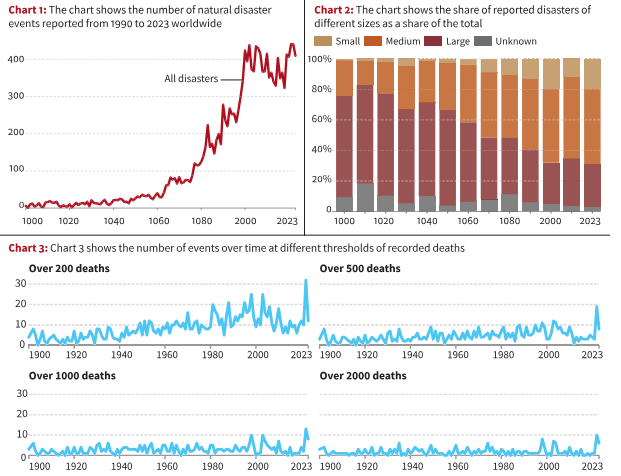Note4Students
From UPSC perspective, the following things are important :
Prelims level: Missing Data and Limitations of Disaster Databases
Why in the news?
The Food and Agriculture Organization (FAO) of the United Nations noted a rise in global disasters from roughly 100 yearly in the 1970s to about 400 in recent years, influenced partly by reporting biases.

Recent Observations
- Increase in Disaster Events: The number of disaster events reported worldwide has risen from 100 events per year in the 1970s to around 400 per year in the last 20 years. Patterns in disaster data reveal factors such as increased resilience, climate change, and improved humanitarian response.
- Improved Reporting: Reporting of small events, particularly those with fewer than 200 deaths, has increased significantly since the 1980s and 1990s. Historical data mainly included major events due to limited interest and capacity for data collection in earlier periods.
Missing Data and Limitations of Disaster Databases
- Biases and Gaps in Historical Records: Earlier records predominantly captured major disasters, with smaller events often missing. Data coverage is particularly poor in low-income regions such as Sub-Saharan Africa and South Asia, where economic losses from disasters are frequently underreported.
- Missing Economic Damage and Insured Losses: More than 40% of disasters between 1990 and 2020 lacked estimates of monetary damages. Insured damages were missing in 88% of disaster reports, and 96% needed records of reconstruction costs.
- No coverage of Heat Events and Health Impacts: Reporting of heat events is concentrated in a few countries, suggesting underreporting in other regions. Indirect health effects of extreme temperatures, such as increased cardiovascular disease risk, are challenging to quantify and often underestimated.
Need for Data (Way Forward)
- Improving Data Coverage: Enhanced data collection in low-income regions and better integration of smaller events into disaster databases are crucial.
- Accurate Health Impact Quantification: Improved methods for estimating indirect health effects of extreme temperatures and other disaster-related conditions are needed. Utilising statistical methods to capture the broader health impacts of disasters can aid in better policy formulation.
- Policy and Resilience Planning: Reliable and comprehensive disaster data are essential for effective policy-making and resilience planning. Data-driven insights and predictive analytics can help foresee the long-term impacts of disasters and guide regulatory measures to enhance disaster preparedness and response.
Mains PYQ:
Q Discuss the recent measures initiated in disaster management by the Government of India departing from the earlier reactive approach. (UPSC IAS/2020)
Get an IAS/IPS ranker as your 1: 1 personal mentor for UPSC 2024
